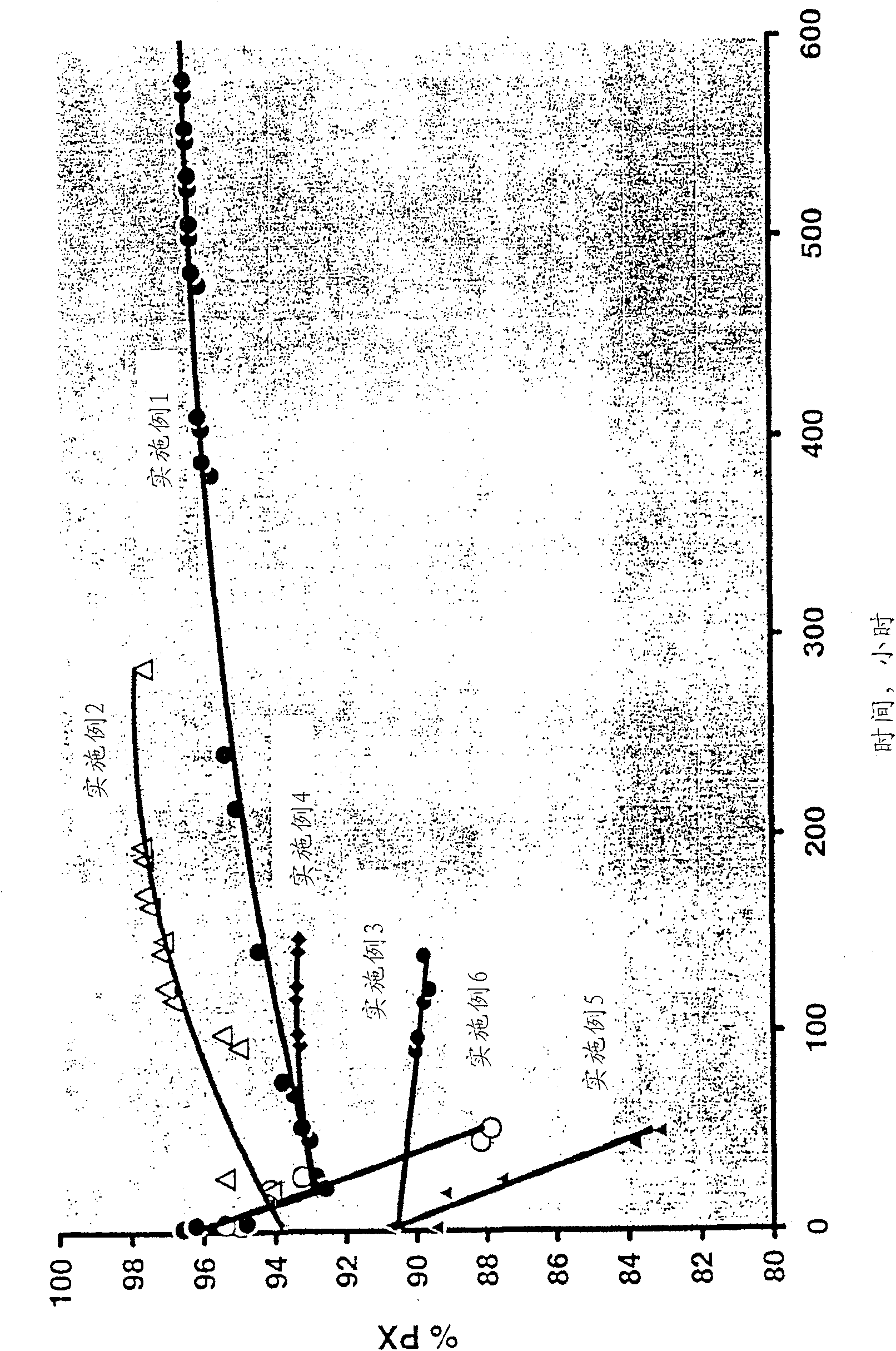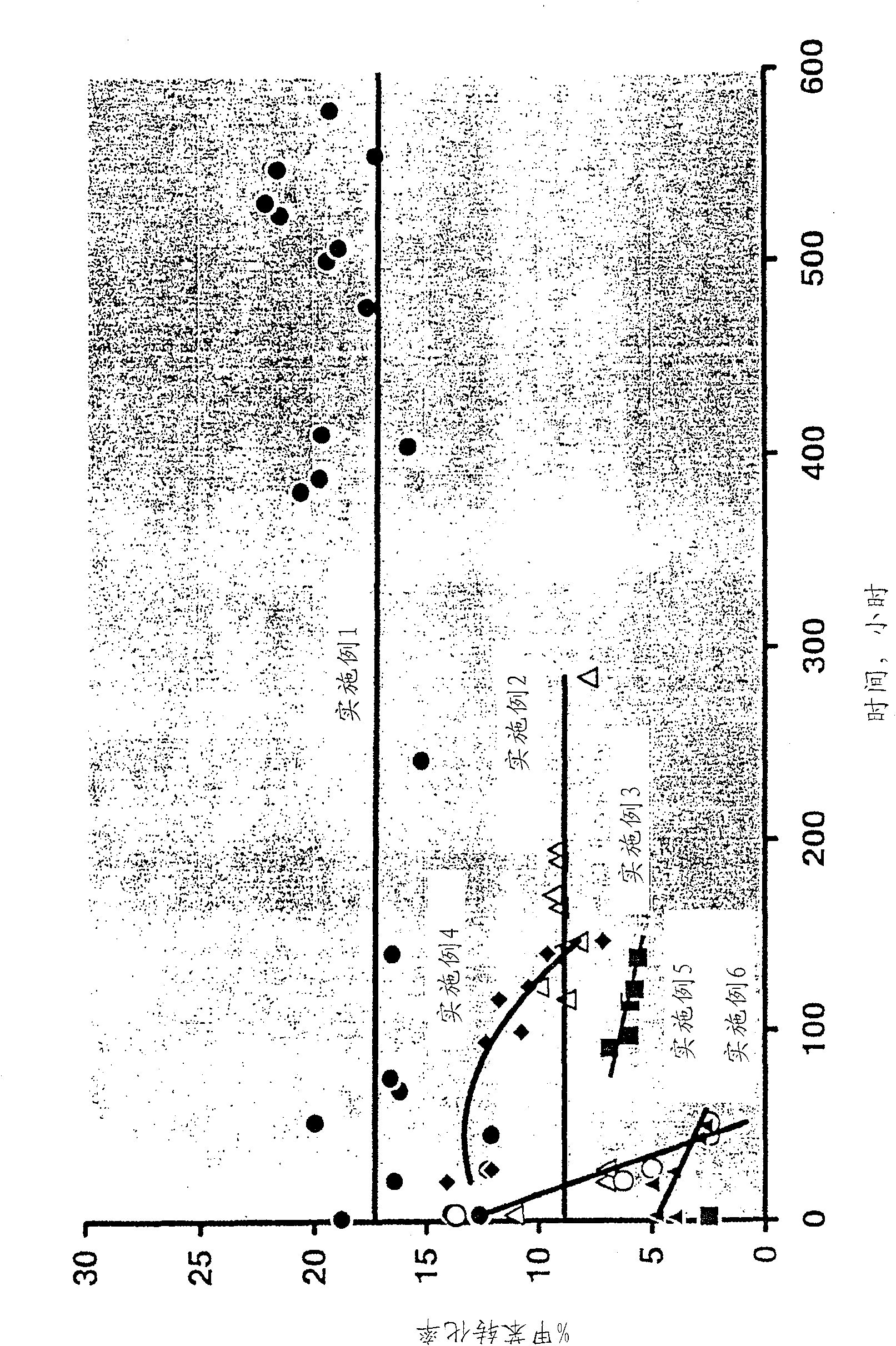Toluene methylation process
一种甲苯、二甲苯的技术,应用在烷基化。领域,能够解决活性降低等问题
- Summary
- Abstract
- Description
- Claims
- Application Information
AI Technical Summary
Problems solved by technology
Method used
Image
Examples
Embodiment 1
[0031] Load 2.70 ml of catalyst into the reactor. The catalyst was dried under a stream of hydrogen at a temperature of 200°C for at least 1 hour before feeding. The reactor pressure was maintained at 20 psig. At about 32hr -1 A pre-mixed toluene / methanol feed with a molar ratio of 1 / 1 was added at a rate of approximately 1.445 ml / min at a low LHSV. Use co-feed hydrogen at a rate of 50cc / min to obtain H 2 The / HC molar ratio is about 0.1. Slowly increase the catalyst bed inlet temperature (10°C / min) and adjust it to about 600°C. After 1 hour from the initial airflow, adjust the operating conditions to the operating conditions. The feed rate is reduced to about 0.089ml / min to obtain LHSV about 2hr -1 . And, the hydrogen rate as a common feed was increased from 50cc / min to 223cc / min to reduce H 2 The molar ratio of / HC is kept at about 7. The reaction start-up conditions and operating conditions, as well as toluene conversion rate and p-xylene selectivity are as described in...
Embodiment 2
[0038] 2.70ml of catalyst was loaded into the reactor, and the catalyst was dried at 200°C under hydrogen flow for at least 1 hour before feeding, and the reactor pressure was maintained at 20psig. The molar ratio of 2 / 1 to the premixed toluene / methanol feed is introduced at a rate of about 0.101ml / min, and the LHSV is about 2hr -1 . Put the hydrogen as co-feed in H 2 / HC was introduced at a rate of 51cc / min at a molar ratio of about 1.6. The inlet temperature of the catalyst bed was slowly increased (10°C / min) and adjusted to 600°C. After the first 27 hours of the flow, the H 2 When the / HC molar ratio is 7.8, the rate of co-feeding hydrogen is increased from 51cc / min to 223cc / min. After 99 hours of flow, at H 2 When the / HC molar ratio is about 1.7, the rate of co-feeding hydrogen is reduced from 223cc / min to 51cc / min. By placing H 2 When the / HC molar ratio is reduced from about 7.8 to 1.7, the conversion rate of toluene is improved. The start-up conditions and normal opera...
Embodiment 3
[0045] 1.40ml of catalyst was loaded into the reactor, and the catalyst was dried in a hydrogen stream at 200°C for at least 1 hour before feeding, and the reactor pressure was maintained at about 20 psig. The toluene / methanol feed premixed at a molar ratio of 2 / 1 is introduced at a rate of about 0.182ml / min, and the LHSV is about 8hr -1 . Use co-feed hydrogen at 471cc / min to obtain H 2 The / HC molar ratio is about 8.0. The inlet temperature of the catalyst bed was slowly increased (10°C / min) and adjusted to about 500°C. The operating conditions of the reactor, as well as the toluene conversion rate and para-xylene selectivity are as described in Tables 3A and 3B.
[0046] Table 3A
[0047]
[0048] Table 3B
[0049]
[0050] From figure 1 with 2 It can also be seen that the p-xylene selectivity in Example 3 was approximately 90% during the 139 hours of reaction operation, while the initial conversion rate was approximately 2%. The data recorded during the 91-139 hours of the str...
PUM
| Property | Measurement | Unit |
|---|---|---|
| conversion efficiency | aaaaa | aaaaa |
Abstract
Description
Claims
Application Information
 Login to View More
Login to View More - Generate Ideas
- Intellectual Property
- Life Sciences
- Materials
- Tech Scout
- Unparalleled Data Quality
- Higher Quality Content
- 60% Fewer Hallucinations
Browse by: Latest US Patents, China's latest patents, Technical Efficacy Thesaurus, Application Domain, Technology Topic, Popular Technical Reports.
© 2025 PatSnap. All rights reserved.Legal|Privacy policy|Modern Slavery Act Transparency Statement|Sitemap|About US| Contact US: help@patsnap.com



